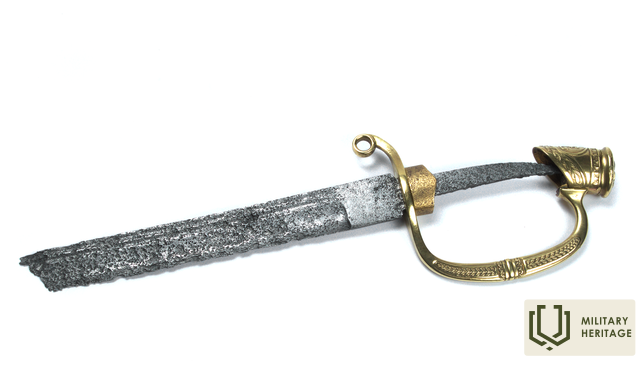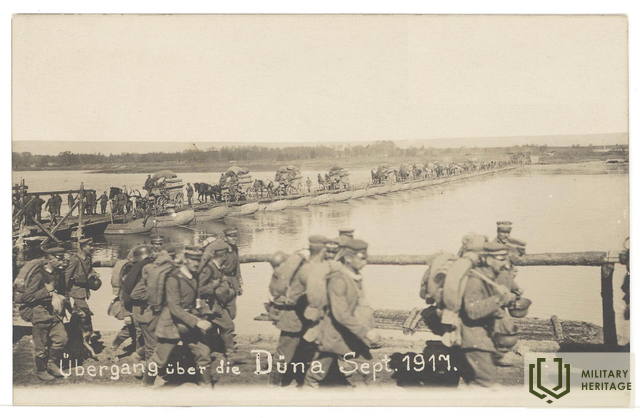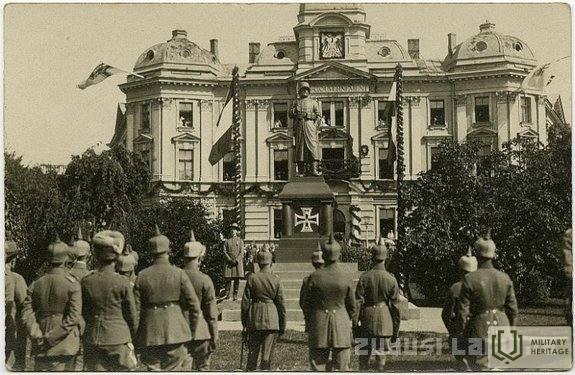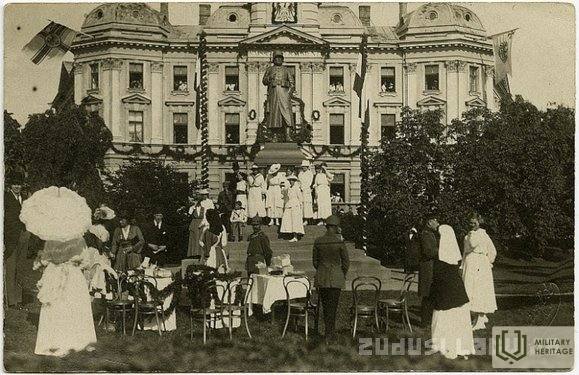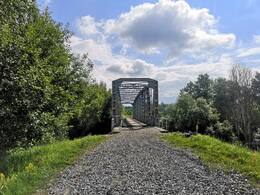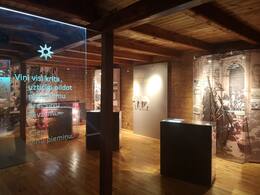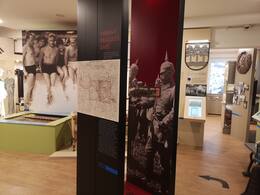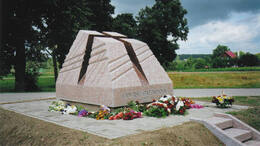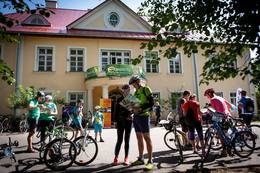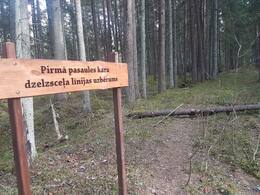Juglos mūšis – Itje puolimas I WW1
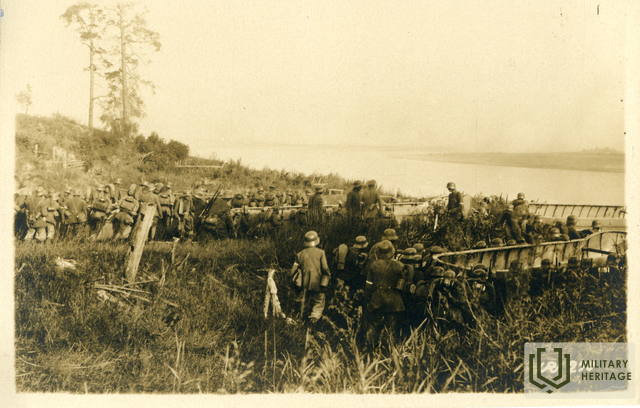
Rygos operacija, karo istorijoje dar žinoma kaip Rygos mūšis arba Hutierų Rygos puolimas (vok. Schlacht um Riga – „Rygos mūšis“, angl. Hutierų puolimas Rygoje), buvo Vokietijos imperijos 8-osios armijos puolamoji operacija Pirmojo pasaulinio karo metu, kurios tikslas buvo užimti Rygą ir apsupti ją ginančių Rusijos Respublikos 12-osios armijos dalinius. Po 1917 m. vasario revoliucijos ir monarchijos panaikinimo Rusijos armijos koviniai pajėgumai su kiekvienu mėnesiu mažėjo. Jau vasaros pabaigoje, remiantis karine terminologija, šiuos karius galima drąsiai vadinti „liaudies milicija“. Mūšiai vyko 1917 m. rugsėjo 1–6 d. Puolime vokiečių pusėje dalyvavo daugiau nei 60 000 kareivių, o rusų pusę gynė 161 000 kareivių. 2-osios Latvijos šaulių brigados kareiviai gynybiniame mūšyje netoli Mazā Juglos sugebėjo užkirsti kelią Rusijos kariuomenei patekti į apsuptį.
Vokietijos 8-osios armijos vyriausiasis vadas Oskaras fon Hutieris norėjo išbandyti naują karo metodą netoli Rygos, kur kelias valandas trukusią itin koncentruotą ir kombinuotą artilerijos ugnį 500 x 400 m stačiakampiuose sekė neatidėliotina pėstininkų ataka. 1917 m. rugsėjo 1 d. rytą, po trijų valandų artilerijos ugnies, vokiečiai pradėjo statyti medinius pontoninius tiltus per Dauguvą. Iš 1159 pabūklų ir minosvaidžių buvo paleista apie 560 000 sviedinių, kurie visiškai numalšino 66 rusų pabūklus ir privertė trauktis 186-ąją diviziją, dislokuotą dešiniajame Dauguvos krante.
Po artilerijos ugnies rugsėjo 2 d. vidury dienos prasidėjo ataka prieš Latvijos šaulių pozicijas. Gynybiniai mūšiai vyko 14 km ilgio fronte palei dešinįjį Mazā Juglos upės krantą. Iki mūšio prie Mazā Juglos upės 2-oji Latvijos šaulių brigada anksčiau nebuvo vykdžiusi jokių bendrų kovinių operacijų, kartais du pulkai veikė kartu vienoje operacinėje grupėje. 1917 m. vasarą brigada gavo pastiprinimą arba žygius iš Latvijos šaulių rezervinio pulko, kuris buvo dislokuotas Valmieros rajone. Prieš Mazā Juglos mūšį 2-oji brigada tris mėnesius, nuo 1917 m. gegužės 15 d. iki rugpjūčio 21 d., buvo pozicijose Ložmetējkalno ir Kalnciemo plento rajone. Šiuo laikotarpiu kovų nebuvo, tačiau ilgas buvimas apkasuose, maisto ir kitos problemos išvargino kareivius.
2-osios Latvijos šaulių brigados kariai, turėdami kelis pabūklus, susidūrė su kiekybiškai ir techniškai stipresne vokiečių kariuomenės grupe, kuri puolime taip pat naudojo aviaciją, liepsnosvaidžius ir nuodais užnuodytus artilerijos sviedinius. Šauliai sugebėjo didvyriškai išlaikyti frontą 26 valandas iki rugsėjo 3 d., kai pagrindinės Rusijos 12-osios armijos pajėgos jau buvo atitrauktos iš Rygos Rygos-Petrogrado geležinkeliu. Įvykdę savo užduotį, išlikę Latvijos kareiviai 12-osios armijos vadovybės įsakymu atsitraukė į Siguldos ir Cėsių pozicijas. Nuostoliai buvo labai dideli – daugiau nei pusė 5-ojo Žemgalės ir 6-ojo Tukumo Latvijos šaulių pulkų kovotojų buvo išmušti iš rikiuotės, 7-asis Bauskės ir 8-asis Valmieros Latvijos šaulių pulkai nukentėjo mažiau.
Daugiau informacijos šaltinių
https://lv.wikipedia.org/wiki/R%C4%ABgas_oper%C4%81cija#cite_note-autogenerated1-1
http://latviesustrelniekusaraksts.lv/Kaujas_darbiba/Book_3.html
Susijusi laiko juosta
Susijusios vietos
Upės slėnio tranšėja
Maršruto pradinis taškas yra Upeslejų centre, netoli autobusų stotelės.
1917 m. rugsėjo 1 d. rytą, po tris valandas trukusios artilerijos ugnies, vokiečiai pradėjo statyti tris medinius pontoninius tiltus per Dauguvą netoli Ikškilės. Iš 1159 pabūklų ir minosvaidžių buvo paleista apie 560 000 sviedinių, kurie visiškai numalšino 66 rusų pabūklus ir privertė trauktis 186-ąją diviziją, dislokuotą dešiniajame Dauguvos krante. Rusijos 12-osios armijos vadas generolas Parskis įsakė 43-iajam korpusui pradėti kontrataką pralaužus gynybos liniją ir perdavė korpuso vado žinioje 33-iąją, 136-ąją, 138-ąją divizijas, vieną 116-osios divizijos brigadą ir 2-ąją Latvijos šaulių brigadą.
Rugsėjo 1-osios popietę Latvijos šauliai gavo įsakymą žygiuoti į kovą su vokiečiais, kertančiai Dauguvą. 2-oji Latvijos šaulių brigada iš Ropažių išskubėjo pasitikti puolančių vokiečių dalinių, o 5-ojo Žiemgalos Latvijos šaulių pulko kariai apie 16 valandą pasiekė įtvirtintas pozicijas dešiniajame Mazos Juglos upės krante. Po artilerijos ugnies rugsėjo 2-osios vidurdienį prasidėjo puolimas prieš Latvijos šaulių pozicijas. Gynybiniai mūšiai vyko 14 km ilgio fronte dešiniajame Mazos Juglos krante. 2-osios Latvijos šaulių brigados kariai, turėdami kelis pabūklus, susidūrė su kiekybiškai ir techniškai stipresne vokiečių kariuomenės grupe, kuri puolime taip pat naudojo aviaciją, liepsnosvaidžius ir nuodais užnuodytus patrankų sviedinius. Šauliai didvyriškai išlaikė frontą 26 valandas iki rugsėjo 3 d. Atlikę savo užduotį, išgyvenę Latvijos kariai 12-osios armijos vadovybės įsakymu atsitraukė į Siguldos ir Cėsių pozicijas. Nuostoliai buvo labai dideli – daugiau nei pusė 5-ojo Zemgalės ir 6-ojo Tukumo latvių šaulių pulkų kovotojų buvo sutriuškinti, o 7-asis Bauskės ir 8-asis Valmieros latvių šaulių pulkai nukentėjo mažiau.
Kultūros paveldo centras „Tīnūžų dvaras“
Kultūros paveldo centras „Tīnūžių dvaras“ yra Ogrės savivaldybėje, Tīnūžių kaime, 7 km nuo Ogrės ir Ikškilės miestų. Pirmieji rašytiniai duomenys apie dvarą siekia XVI a. Iki XVIII a. vidurio jis buvo laikomas ekonominiu gamybos vienetu su mažais ir nereikšmingais pastatais. Tačiau laikui bėgant jis išaugo į didelį ūkį. Pirmojo pasaulinio karo metu čia vyko Rusijos ir Vokietijos armijų mūšiai, kuriuose dalyvavo ir Latvijos šauliai. Nepriklausomybės karo metu Tīnūžių dvaras buvo naudojamas kaip Latvijos armijos 1-ojo Valmieros pėstininkų pulko štabas ir šarvuočių aikštelė. 1932 m. dvaras buvo perduotas Latvijos karo invalidų sąjungai, kuri apgyvendino ir rūpinosi karo veteranais. Antrojo pasaulinio karo metu (1943 m.) iš Estijos į Tīnūžių dvarą buvo perkeltas Vokietijos armijos dalinys FAT 212. Tai buvo diversantų dalinys, rengęs karius kovai su Raudonąja armija. Latvijos kareiviai taip pat buvo apmokyti žvalgybos rinkimo, partizaninio karo taktikos ir sabotažo menų. Tīnūžių dvaro pono rūmai buvo sugriauti, kai Raudonoji armija judėjo Rygos link. Šiandien tai vieta su nuostabiu kraštovaizdžiu ir istoriniais pastatais Mažosios Juglos upės pakrantėje. Kultūros paveldo centre „Tīnūžių dvaras“ galima pamatyti ekspozicijas, skirtas istoriniams įvykiams, įskaitant ir tas, kurios susijusios su Latvijos šauliais.
Ogros istorijos ir meno muziejus
Ogrės istorijos ir meno muziejus įkurtas 1981 m. Muziejaus kolekciją sudaro daugiau nei 40 tūkstančių skirtingų vienetų, surinktų Ogrės miesto ir buvusio Ogrės rajono teritorijoje. Muziejuje plačiai vaizduojamas kultūrinis ir istorinis paveldas nuo seniausių laikų iki šių dienų.
Parodoje „Iš banko į muziejų“ lankytojai gali susipažinti su pastato Brīvības gatvėje 36 istorija ir jo transformacija per 50 metų laikotarpį. Iš pradžių pastatytas kaip SSRS bankas, pastaruoju metu jame įsikūręs Ogrės istorijos ir meno muziejus.
Ekspozicija „Poilsiautojai Ogrėje“ skirta vienam ryškiausių ir legendiškiausių miesto istorijos puslapių. Joje rodomos poilsio galimybės, poilsiautojų pramogos, taip pat legendos, apipinusios Ogrės kultūrinį ir socialinį gyvenimą nuo XX a. pradžios iki Antrojo pasaulinio karo. Ogrės, kaip kurortinio miesto, gyvenimo istorija pateikiama kruopščiai atrinktais dokumentais ir objektais bei patraukliu meniniu pateikimu.
Muziejaus parodos keičiasi kas mėnesį. Teminės parodos paprastai skirtos skirtingiems istoriniams įvykiams, tačiau meno parodose pristatomi menininkai, tokie kaip tapytojai, keramikai, grafikos dizaineriai, fotografai ir kitų kūrybinių profesijų atstovai iš Ogrės savivaldybės ir visos šalies.
Paminklas Mažosios Juglos mūšiui Tīnūžuose
Įsikūręs Tīnūžių kaime, Ikškilės savivaldybėje, pakelėje, netoli Tīnūžių pradinės mokyklos.
Paminklas Latvijos šauliams, kovojusiems prieš Vokietijos armiją Pirmojo pasaulinio karo metu. Mažosios Juglos upės mūšis 1917 m. rugsėjo 1–2 d. buvo Rygos operacijos kulminacija. Vokietijos armija pradėjo puolimą prieš Ikškilę, siekdama užimti Rygą ir sučiupti Rusijos 12-ąją armiją. Vokiečių armijos daliniai, perėję Dauguvą pontoniniais tiltais, pasiekė Mažosios Juglos upės apylinkes, kur juos užblokavo Latvijos šauliai. Jiems buvo įsakyta sulaikyti priešą, kol visa Rusijos 12-oji armija ištrūks iš apsupties, nepatekdama į Vokietijos armijos sugavimą. Kovos vyko su dideliais abiejų kariaujančių pusių nuostoliais.
Šiandien galite aplankyti 2005 m. atidengtą skulptoriaus Janio Karlovo paminklą „Didvyrių altorius“, skirtą Latvijos kovotojams. Už 300 metrų yra Tīnūžių dvaras, kuriame įrengta ekspozicija.
Mercendarbės dvaras
Įsikūręs Balduonės savivaldybėje, 4 km nuo Balduonės, netoli Iecavos – Balduonės – Daugmalės plento.
Mercendarbė yra vienas iš dvarų, šalia kurio buvo įsikūręs seniausias Latvijoje Balduonės SPA centras. Dvaro istoriją papildo Pirmojo pasaulinio karo įvykiai. Jis buvo įsikūręs 7 km atstumu nuo aktyvios fronto kovos vietos – Navės salos. Mercendarbės dvaras tarnavo Vokietijos armijos reikmėms, o jo apylinkės tapo tiesiogine karo liudininke.
Karo metu geležinkelių infrastruktūra buvo vienas svarbiausių klausimų kiekvienos armijos planuose. 1915 m. Vokietija buvo okupavusi Latvijos teritoriją (tuo metu Rusijos dalį) ir pradėjo tiesti naujas geležinkelio linijas, kad galėtų greitai pervežti kareivius, organizuoti tiekimą ir eksportuoti išteklius į Vokietiją, pavyzdžiui, medienos krovinius. Viena iš naujųjų geležinkelio linijų sujungė Mercendarbi su Vecumniekiais ir toliau su Jelgava, kuri buvo svarbus Vokietijos armijos atramos taškas. Mercendarbi linija buvo naudojama aprūpinti kareivius Mirties saloje, taip pat teikė paramą Vokietijos armijos daliniams, kai šie puolė Rygą, kirsdami Dauguvą.
Šiandien dvare įsikūręs Balduonės muziejus ir turistų informacijos punktas. Įkurtas samdinių pėsčiųjų takas, kuris yra „Balduonės pasakojimų tako“ dalis. Vis dar galima pamatyti vokiečių armijos geležinkelio pylimą.
Vokietijos karinio geležinkelio atkarpa Mercendarbės-Skarbės maršrute
Gamtoje aiškiai matomas buvęs geležinkelio maršrutas, nes geležinkelio pylimas išlikęs praktiškai visame kelio ruože, kur šiandien yra miškas. Eidami pylimu atkreipkite dėmesį į žemės dangą – galima pamatyti išlikusias pabėgių vietas. Šiandien kai kurios geležinkelio atkarpos tarnauja kaip kelių pagrindas, pavyzdžiui, miško kirtimo takas. Netoli Mercendarbės dvaro geležinkelio pylimas išlygintas, tačiau netoli Riekstukalns, kur atsinaujina miškas, jis tęsiasi.
Balduonės istorijos tyrinėtojas O. Andersonas apie šio geležinkelio istoriją rašo taip:
„Pirmojo pasaulinio karo metu, kai 1916 m. fronto linija stabilizavosi palei kairįjį Dauguvos upės krantą, siekiant aprūpinti vokiečių armiją, 1916 m. kovo 15 d. armijos geležinkelio tarnybos vadas nusprendė nutiesti liniją iš Vecumniekų į Mencendarbius. Linijos ilgis buvo 25 kilometrai. Kovo 30 d. darbus pradėjo 5000 darbininkų, o iki gegužės 1 d. linija buvo nutiesta iki Skarbės stoties, o iki gegužės 6 d. – iki Mercendarbių. Geležinkelis prasidėjo Vecumniekuose kaip Neugut Kurland stotis, vėliau Nugut Nord, Birsemniek, Gedeng, Skarbės, Merzendorfo stotys (vokiški pavadinimai). Vėliau linija buvo pratęsta iki Riekstu kalno ir iki Vilki kalno priešais Ikškilę. Kadangi Jelgavos–Krustpilio linija jau buvo atstatyta pagal vokišką (Vakarų Europos) vėžę, jos plotis buvo 1435 mm. Tai nebebuvo kažkoks „tiltelis“, o įprastas...“ geležinkelis. Didžiausia stotis buvo Skarbė. Joje taip pat vyko didžiausi krovinių krovos darbai, kad juos būtų galima gabenti į frontą arklių transportu. Geležinkelio linija dar veikė 1921 m., kai ja buvo siunčiami rąstai ir malkos. Ji buvo nugriauta 1925 m. Šiandien stoties vieta išlikusi nepaliesta, galima pamatyti geležinkelio bėgius, bėgių pylimą ir pabėgių vietas. Nuostabu, kad po 100 metų galime vaikščioti šiuo geležinkeliu. Jaučiasi taip, lyg tuoj atvažiuotų traukinys ir tektų pasitraukti.“
Susijusi istorija
Mažosios Juglos upės mūšis / Rygos operacija
Pasakotojas aprašo savo įspūdžius apie Rygos operacijos pradžią, kai vokiečių armijos artilerija pradeda apšaudyti Rusijos armijos pozicijas. Jis aprašo Rusijos armijoje tvyrantį chaosą ir Latvijos šaulių nuotaikas prieš mūšius.




